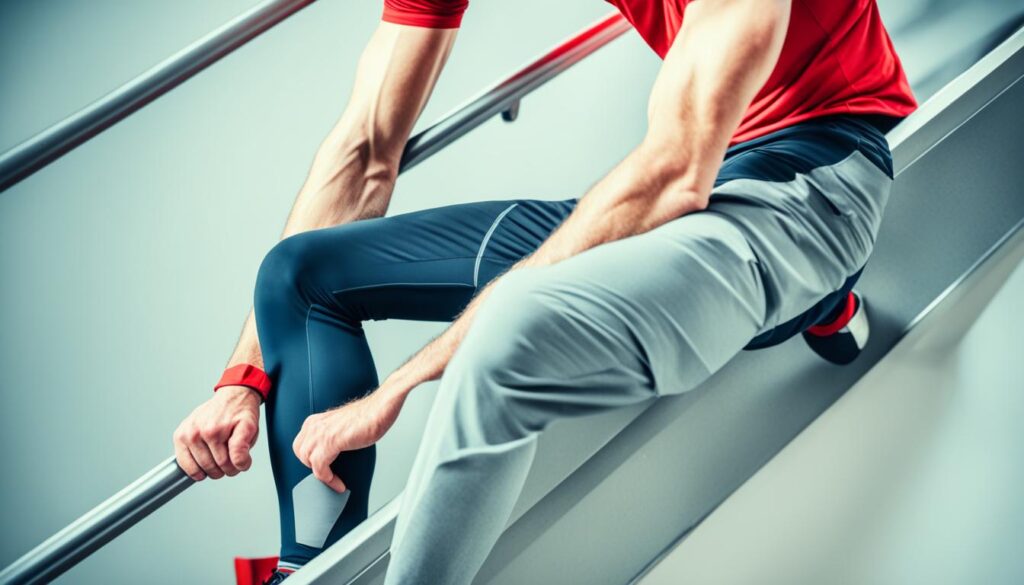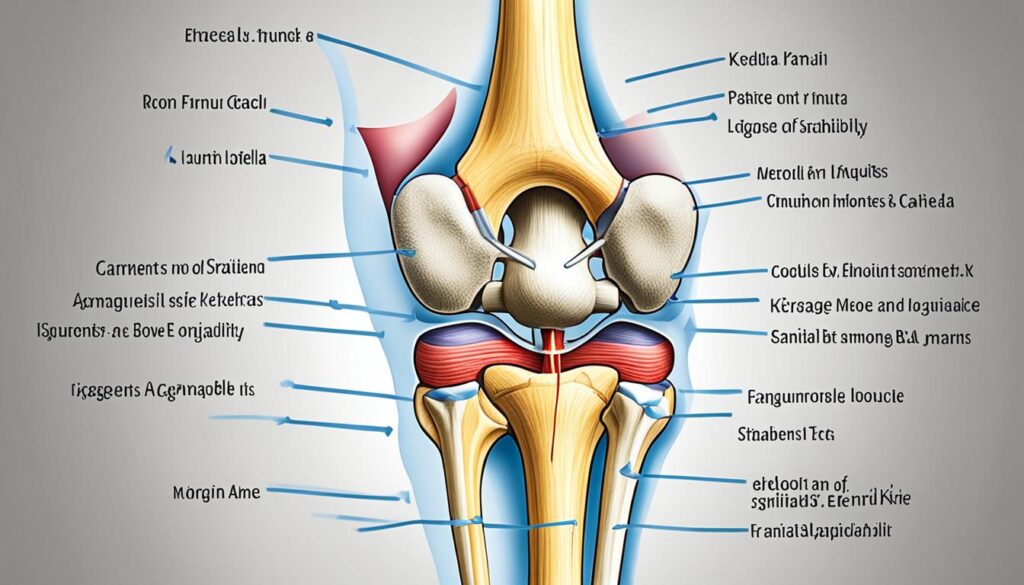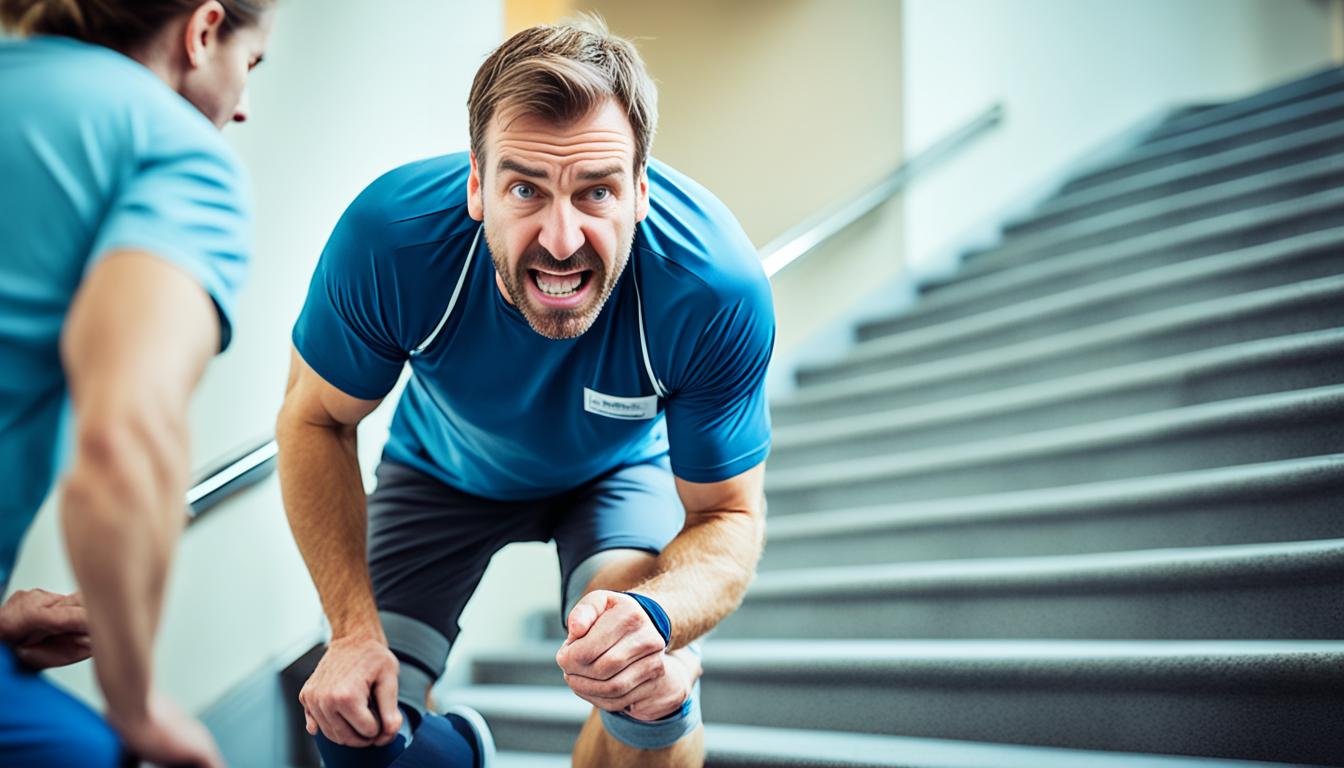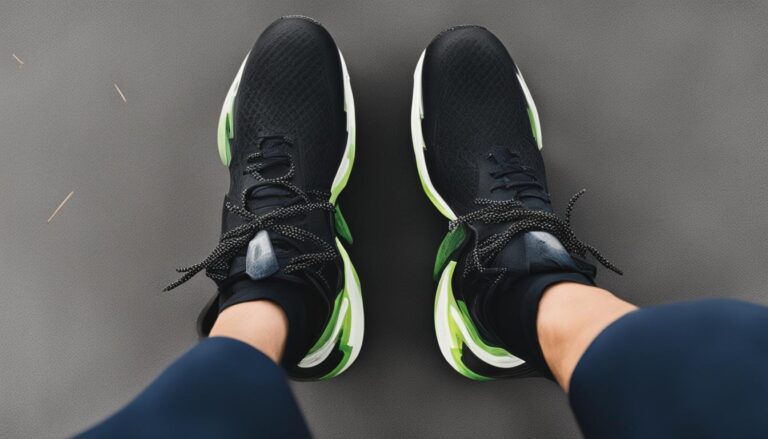Knee Cap Hurts When Walking Up Stairs? Get Help!
Walking up stairs can be a painful experience for those dealing with knee cap pain. The extra pressure on the knees when climbing stairs, combined with the movement at an angle and against gravity, can exacerbate existing knee issues. Factors such as overuse, underlying health conditions, or muscle imbalances can contribute to knee pain when climbing stairs. Understanding the various causes of knee pain and implementing preventative measures can help alleviate discomfort and improve mobility. Strengthening exercises and modifications to walking technique can be effective ways to manage knee pain when ascending stairs. Consulting a physical therapist for recommended exercises and personalized guidance can provide valuable insights for pain relief.
Key Takeaways:
- Knee pain when climbing stairs can be caused by various factors such as patellofemoral pain syndrome, meniscus tears, and muscle imbalances.
- Understanding the knee anatomy, including the patella, femur, tibia, ligaments, tendons, cartilage, menisci, bursae, muscles, and nerves, can help in identifying the source of knee pain.
- Prevalent knee conditions like chondromalacia patella, osteoarthritis, ligament injuries, and patellofemoral pain syndrome can cause knee pain when climbing stairs.
- Managing knee pain when climbing stairs involves strategies such as targeted exercises, modifying walking technique, and strengthening and flexibility exercises.
- Seeking professional help from a physical therapist can provide personalized guidance, pain relief, and improved joint mobility when dealing with knee pain.
What Causes Knee Pain When Climbing Stairs?
Knee pain when climbing stairs can be a common and frustrating issue, making everyday tasks challenging and uncomfortable. Understanding the specific causes of knee pain when ascending stairs can help in developing targeted treatment and management strategies.
Patellofemoral Pain Syndrome
One potential cause of knee pain when climbing stairs is patellofemoral pain syndrome, also known as “runner’s knee”. This condition often arises from overuse or a sudden increase in physical activity. The repetitive movement of climbing stairs can aggravate the knee joint, resulting in pain and discomfort.
Meniscus Tears
Meniscus tears are another common cause of knee pain when ascending stairs. These tears can occur due to pivoting or twisting movements, leading to inner or outer knee pain. The strain placed on the knee joint when climbing stairs can exacerbate the symptoms of a meniscus tear, making each step painful.
Chondromalacia Patella
Chondromalacia patella is characterized by softening and breakdown of the cartilage behind the kneecap. This condition can cause irritation and a dull ache in the kneecap when climbing stairs. The repetitive motion of stair climbing can worsen the symptoms, leading to increased discomfort.
IT Band Syndrome
IT band syndrome can also contribute to knee pain when climbing stairs. This condition arises when the iliotibial (IT) band, a thick band of fibrous tissue, becomes inflamed or tight. It can cause pain on the outside of the knee, particularly when descending stairs. However, the strain placed on the knee during stair climbing can also lead to discomfort.
Muscle Imbalances
Muscle imbalances, particularly being quad-dominant, can put extra pressure on the front of the knee when climbing stairs. Weakness or tightness in certain muscle groups can disrupt the proper movement and alignment of the knee joint, leading to pain and discomfort.
By identifying the specific cause of knee pain when climbing stairs, individuals can work with healthcare professionals to develop a targeted treatment plan. Treatment options may include physical therapy, exercises to strengthen imbalances in muscle groups, and modifications to activity levels to reduce strain on the knee joint.

Proper diagnosis and management of knee pain when ascending stairs are crucial for improving overall quality of life and maintaining mobility. If you are experiencing persistent knee pain, it is recommended to consult with a healthcare professional for an accurate diagnosis and personalized treatment approach.
Understanding the Knee Anatomy
The knee is a complex joint composed of several components. It plays a crucial role in supporting our body weight and facilitating movement. Let’s explore the different elements that make up the knee and their functions.
Knee Bones
The knee joint includes three main bones:
- The patella (kneecap), a small triangular bone at the front of the knee that protects the joint.
- The femur (thigh bone), the longest and largest bone in the body that forms the upper part of the knee joint.
- The tibia (shin bone), the second-largest bone in the body that forms the lower part of the knee joint.
Ligaments, Tendons, and Cartilage
The knee joint is stabilized and supported by various ligaments, tendons, and cartilage. Ligaments are strong, fibrous tissues that connect bones to other bones, providing stability. Some key knee ligaments include collateral ligaments and cruciate ligaments.
Tendons, on the other hand, connect muscles to bones. In the knee, tendons play a crucial role in facilitating movement and stability.
Cartilage is a smooth, rubbery tissue that covers the ends of bones and acts as a shock absorber. It allows the knee bones to glide smoothly against each other, reducing friction and preventing damage.
Menisci and Bursae
The knee joint also contains menisci and bursae, which further enhance its functionality and protect it from injuries.
The menisci are two wedge-shaped pieces of cartilage located between the femur and tibia. They help distribute the body’s weight across the knee joint, absorb shock, and improve the stability of the joint.
Bursae are small fluid-filled sacs that cushion the knee joint and reduce friction between the bones, tendons, and muscles.
Muscles and Nerves
Several muscles surround and support the knee joint, allowing for its movement and stability. These muscles, including the quadriceps and hamstrings, work together to flex, extend, and rotate the knee.
Nerves play a vital role in transmitting signals between the brain and the knee joint, enabling us to perceive sensations and control movements.
Understanding the anatomy of the knee can help us appreciate the complexity of this joint and the importance of maintaining its health. By taking care of each component, we can minimize the risk of knee injuries and ensure optimal joint function.

Prevalent Knee Conditions
When it comes to knee pain, there are several prevalent knee conditions that can cause discomfort, especially when walking up stairs. Understanding the causes, symptoms, and treatment options for these conditions can help individuals seek appropriate care and find relief.
Chondromalacia Patella
Chondromalacia patella, also known as “runner’s knee,” can occur due to trauma, overuse, or misalignment of the kneecap. This condition often causes pain in the front or middle of the knee, along with soreness when going up and down stairs and stiffness.
Osteoarthritis
Osteoarthritis is a degenerative condition that occurs when the cartilage in the knee joint breaks down. This can lead to pain, swelling, and limited mobility. Climbing stairs can exacerbate these symptoms, making it particularly challenging for individuals with osteoarthritis.
Ligament Injuries
Ligament injuries, such as ACL, PCL, MCL, or LCL injuries, can cause knee pain, swelling, and instability. These types of injuries often result from sudden twists or direct impact to the knee joint. Walking up stairs can put additional stress on the injured ligaments, leading to discomfort.
Patellofemoral Pain Syndrome
Patellofemoral pain syndrome is characterized by a dull pain around the kneecap. It can be caused by overuse or incorrect technique while playing sports. The repetitive motion of climbing stairs can worsen the pain associated with this condition.
It’s important to note that each knee condition may require a different approach to treatment. Consulting with a healthcare professional, such as a physical therapist, is essential for an accurate diagnosis and personalized treatment plan.
| Knee Condition | Causes | Symptoms | Treatment |
|---|---|---|---|
| Chondromalacia Patella | Trauma, overuse, misalignment | Pain in front/middle of knee, soreness when using stairs, stiffness | Physical therapy, pain management, strengthening exercises, surgery if necessary |
| Osteoarthritis | Degeneration of knee cartilage | Pain, swelling, limited mobility | Physical therapy, medication, pain management techniques, joint injections, surgery if necessary |
| Ligament Injuries | Sudden twists, direct impact | Knee pain, swelling, instability | RICE method (Rest, Ice, Compression, Elevation), physical therapy, bracing, surgery if necessary |
| Patellofemoral Pain Syndrome | Overuse, incorrect technique | Dull pain around kneecap | Physical therapy, activity modification, pain management techniques |
In some cases, a combination of treatments may be recommended to effectively manage knee pain. This can include physical therapy exercises to strengthen the surrounding muscles, pain management techniques, and in severe cases, surgical intervention.
Tips for Managing Knee Pain When Climbing Stairs
When it comes to managing knee pain while climbing stairs, there are several strategies that can help provide relief. Incorporating targeted exercises, improving body awareness, and modifying your walking technique can make a significant difference in your comfort and mobility. Let’s explore some tips for managing knee pain when ascending stairs:
1. Targeted Exercises
Engaging in specific exercises can strengthen the structures around your knees and alleviate pain. Consider incorporating the following exercises into your routine:
- Hip flexor stretches: Stretching the muscles in the front of your hips can improve flexibility and reduce pressure on the knees.
- Single-leg lifts: Strengthening the muscles around your knee joint can provide stability and support while climbing stairs.
- Hamstring stretches: Stretching the muscles at the back of your thighs can improve flexibility and reduce strain on the knee joint.
2. Body Awareness
Developing body awareness is crucial in managing knee pain. By understanding your body’s movement patterns and making necessary adjustments, you can reduce the strain on your knee joints. Focus on maintaining proper posture and alignment while climbing stairs. Pay attention to the positioning of your hips, knees, and feet, and ensure that your weight is evenly distributed.
3. Modifying Your Walking Technique
Adjusting your walking technique can significantly alleviate knee pain. Consider the following modifications:
- Use a wall or railing for support: Holding onto a stable surface can provide additional support and reduce strain on your knees.
- Engage your glutes and hamstrings: By activating the muscles in your buttocks and thighs, you can distribute the workload and reduce the pressure on your knees.
- Keep weight in your heels: Shifting your weight to your heels while climbing stairs can help reduce stress on the knees and promote better alignment.
Remember, different techniques work for different individuals, so it’s important to experiment and find what works best for your unique situation. Consulting with a healthcare professional or a physical therapist can provide expert guidance and personalized recommendations tailored to your specific needs.
Implementing these tips can help you effectively manage knee pain while climbing stairs, enhancing your mobility and overall quality of life. By combining targeted exercises, increasing body awareness, and modifying your walking technique, you can find relief and regain your ability to navigate stairs with confidence and comfort.
Importance of Strengthening and Flexibility Exercises
Strengthening and flexibility exercises play a crucial role in managing knee pain when climbing stairs. By incorporating these exercises into your daily routine and maintaining consistency, you can experience significant improvements in knee pain and overall functionality.
One key aspect of strengthening exercises is focusing on the hip muscles. Strengthening the hip muscles helps stabilize the pelvis and reduces pressure on the front of the knee. By engaging not just the quadriceps, but also the glutes and hamstrings, you can achieve better balance and support while climbing stairs.
Flexibility exercises are equally important for managing knee pain. Stretching the hamstrings and hip flexors can improve overall mobility and relieve tightness in the leg muscles. By increasing flexibility, you can reduce strain on the knees and enhance your ability to navigate stairs with greater ease.
The Benefits of Strengthening and Flexibility Exercises:
- Promote stability and reduce stress on the knees
- Improve muscle balance and support while climbing stairs
- Enhance overall mobility and flexibility in the legs
- Relieve tightness and discomfort in the leg muscles
- Support proper alignment and movement of the knee joint
By incorporating a variety of strengthening and flexibility exercises into your routine, you can effectively manage knee pain and improve your ability to climb stairs without discomfort. Remember to consult with a healthcare professional or physical therapist for personalized guidance and exercises tailored to your specific needs.
Importance of Seeking Professional Help
When dealing with knee pain when climbing stairs, seeking professional help from a physical therapist is essential. A physical therapist can provide personalized guidance, recommend specific exercises, and address any underlying issues that may be contributing to the pain. By working with a physical therapist, individuals can benefit from their expertise and experience in managing knee pain effectively.
One of the primary advantages of seeking professional help is gaining access to targeted exercises that specifically address the individual’s knee pain. A physical therapist can design a personalized exercise program that focuses on strengthening the muscles around the knee joint, improving joint stability, and enhancing overall function. These exercises can target the specific areas that require attention and help alleviate pain while improving joint mobility.
Moreover, a physical therapist can assess joint mobility and identify any imbalances or weaknesses that may be contributing to knee pain. They can perform a thorough evaluation of the individual’s knee joint, muscle strength, and range of motion to determine the underlying causes of the pain. Based on this assessment, the physical therapist can create a tailored treatment plan that addresses the root causes and provides effective pain relief strategies.
Working with a physical therapist offers the advantage of receiving personalized guidance throughout the rehabilitation process. The physical therapist can provide hands-on assistance, instruct proper form and technique during exercises, and offer valuable feedback and adjustments. This personalized guidance ensures that the individual performs exercises correctly, minimizing the risk of further injury and maximizing their effectiveness in relieving pain.
“A physical therapist can provide personalized guidance, recommend specific exercises, and address any underlying issues that may be contributing to the pain.”
Additionally, a physical therapist can monitor progress and make necessary adjustments to the treatment plan. They can track the individual’s response to exercises and modify the program accordingly, ensuring that each session builds upon the previous one. This ongoing monitoring and adjustment process optimize the benefits of rehabilitation and help accelerate pain relief and recovery.
In conclusion, seeking professional help from a physical therapist is crucial for effectively managing knee pain when climbing stairs. Their expertise in providing personalized guidance, recommending specific exercises, and assessing joint mobility can significantly contribute to pain relief and improved knee function. By working closely with a physical therapist, individuals can receive the necessary support and guidance to overcome knee pain and regain their mobility.
| Benefits of Seeking Professional Help | Explanation |
|---|---|
| Personalized guidance | A physical therapist can provide individualized support and advice throughout the rehabilitation process, ensuring exercises are performed correctly and maximizing their effectiveness. |
| Targeted exercises | A physical therapist can design a tailored exercise program that specifically targets the areas contributing to knee pain, helping to strengthen the muscles and improve joint stability. |
| Assessment of joint mobility | A physical therapist can assess joint mobility and identify any imbalances or weaknesses contributing to knee pain, allowing for a targeted treatment plan. |
| Monitoring and adjustment | The physical therapist can monitor progress and make necessary adjustments to the treatment plan, ensuring ongoing improvement and pain relief. |
Conclusion
Knee pain when climbing stairs can significantly impact our daily lives. However, managing and alleviating knee pain is within our reach. By understanding the specific causes of knee pain, implementing targeted exercises, modifying our walking technique, and seeking professional help from a physical therapist, we can find relief and improve our mobility. Committing to these recommended practices and taking proactive steps will enable us to regain our ability to climb stairs without discomfort. It is important to consult with a healthcare professional to determine the best course of action for our specific condition, ensuring effective knee pain management.
Through a combination of exercises, pain relief techniques, and physical therapy, we can mitigate knee pain and improve overall mobility. Targeted exercises that focus on strengthening the affected muscles and increasing flexibility can provide substantial pain relief. Moreover, retraining our walking technique can reduce stress on the knees, resulting in improved mobility and reduced pain while climbing stairs. Seeking professional help from a physical therapist is crucial, as they can provide personalized guidance, recommend specific exercises, and ensure proper form to maximize the effectiveness of the treatment plan.
Remember, taking the necessary steps to manage knee pain not only provides relief but also enhances our quality of life. By investing in our knee health through exercises, pain relief strategies, and physical therapy, we can regain our independence and enjoy a more active and pain-free lifestyle. With determination and the right support, knee pain can be effectively managed, enabling us to embrace life’s challenges with confidence and ease.
FAQ
Why does my knee hurt when I climb stairs?
Knee pain when climbing stairs can be caused by factors such as overuse, underlying health conditions, or muscle imbalances. The extra pressure on the knees when climbing stairs, combined with the movement at an angle and against gravity, can exacerbate existing knee issues.
What are the common causes of knee pain when climbing stairs?
Knee pain when climbing stairs can be caused by patellofemoral pain syndrome, meniscus tears, chondromalacia patella, IT band syndrome, and muscle imbalances.
How does the knee anatomy contribute to knee pain when climbing stairs?
The knee is a complex joint composed of several components, including the patella (kneecap), femur (thigh bone), tibia (shin bone), ligaments, tendons, cartilage, menisci, bursae, muscles, and nerves. Issues with any of these structures can contribute to knee pain when climbing stairs.
What are some prevalent knee conditions that cause pain when climbing stairs?
Some prevalent knee conditions include chondromalacia patella, osteoarthritis, ligament injuries, and patellofemoral pain syndrome.
How can I manage knee pain when climbing stairs?
Strategies for managing knee pain when climbing stairs include targeted exercises, modifications to walking technique, and seeking professional help from a physical therapist for personalized guidance and treatment.
Why are strengthening and flexibility exercises important in managing knee pain?
Strengthening exercises can help stabilize the knee and reduce pressure on the front of the knee, while flexibility exercises can improve mobility and relieve tightness in the leg muscles.
Should I seek professional help for knee pain when climbing stairs?
Yes, it is recommended to seek professional help from a physical therapist. They can provide personalized guidance, recommend specific exercises, and address any underlying issues contributing to the pain.
How can I effectively manage knee pain when climbing stairs?
By understanding the specific causes of knee pain, implementing targeted exercises, modifying walking technique, and seeking professional help from a physical therapist, individuals can effectively manage and alleviate knee pain when climbing stairs.






